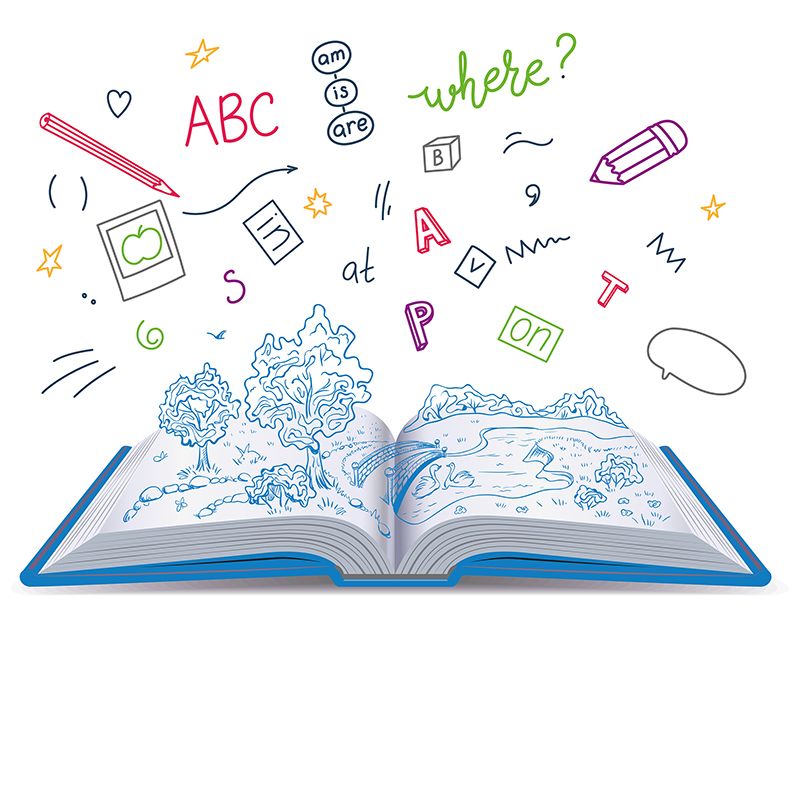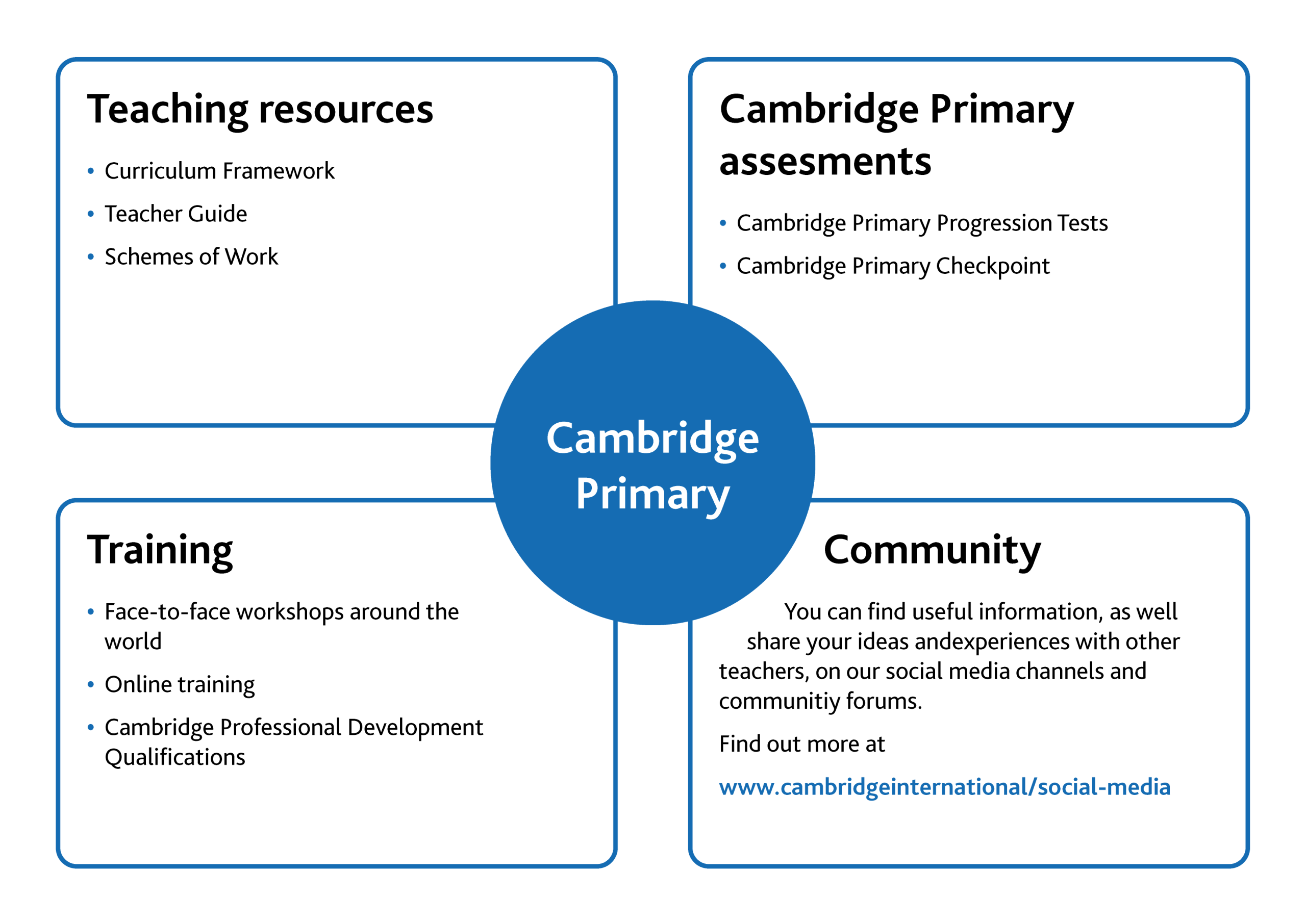A guide to
Cambridge Primary English

Introduction
Cambridge Primary English learners develop skills that they can apply to a range of different purposes and audiences in everyday situations. Learners will learn to communicate confidently and effectively. They will also develop the critical skills to respond to a range of information, media and texts with understanding and enjoyment.
Our Cambridge Primary English curriculum is designed for learners who have English as a first language: those who either speak English at home or have other significant experience of communicating in English (for example at an English-speaking kindergarten). It can be used in any cultural context.
Cambridge Primary English learners:
- become confident communicators, able to apply their reading, writing, speaking and listening skills effectively in everyday situations and in a range of subjects
- see themselves as readers, engaging with a range of texts for information and for pleasure, including texts from different times and cultures
- see themselves as writers, using the written word clearly and creatively for a range of different audiences and purposes
- develop speaking and listening skills for effective presentation and collaboration, sharing and responding to ideas to achieve a shared understanding or goal
- develop a broad vocabulary and an understanding of how to apply grammar and linguistic conventions appropriately
- develop skills to evaluate spoken and written texts, making decisions about how convincingly they represent different values and opinions.
Teaching Cambridge Primary English
We provide a wide range of practical resources, detailed guidance, innovative training and professional development so that you can give your learners the best possible experience of Cambridge Primary English.

We believe that for teaching and learning to be effective, there should be alignment between curriculum, pedagogy and assessment. We have designed Cambridge Primary English around this principle:

Curriculum – taken from Primary English Curriculum Framework
4Rv.08 Comment on the impact of figurative language in texts, including alliteration and similes.
Pedagogy – 4Rv.08 activity taken from the Stage 4 Scheme of Work
Ask learners to discuss what is special about the sentences. Elicit that each sentence contains a series of words that begin with the same sound. Introduce the word alliteration as the name for this language feature.
Organise learners into groups. Ask them to close their eyes and read them an extract from your chosen fantasy story that contains particularly imaginative and descriptive examples of figurative language. Ask learners:
- What did you see in your head when you heard that reading?
- Did anyone else see the same image in their head as you?
- Why do you think it made you think of different things?
- Why did the writer choose to write it like that?
Give learners an extract from your chosen fantasy story that contains examples of figurative language, such as onomatopoeia and any others that they might recognise but not be able to name. Ask each group to identify the figurative language used in the extract and discuss what images they create, paying attention to the words that they feel are most important. Ask the groups to decide whether the figurative language in the text:
- creates a picture in their head
- creates mood and atmosphere
- makes it easier for them to use their imagination.
Assessment – question assessing 4Rv.08 taken from a Stage 4 Progression Test
‘The latest buzz in robots is a mechanical bee modelled on a real insect’ (line 1)
Give one reason why the writer chooses to use the word ‘buzz’.
Curriculum Framework
The Cambridge Primary English Curriculum Framework is available to download on the English (0058) page of the Cambridge Primary support site. It provides a comprehensive set of learning objectives that give a structure for teaching and learning and can be used to assess learners' attainment and skills development.
We have divided the learning objectives into three main areas called ‘strands’, which run through every stage. The strand titles reflect the four language skills:

Each strand is further subdivided into ‘sub-strands’:
| Reading | Writing | Speaking and Listening |
|---|---|---|
| Word structure (phonics) | Word structure (spelling) | Making yourself understood |
| Vocabulary and language | Vocabulary and language | Showing understanding |
| Grammar and punctuation | Grammar and punctuation | Group work and discussion |
| Structure of texts | Structure of texts | Performance |
| Interpretation of texts | Creation of texts | Reflection and evaluation |
| Appreciation and reflection | Presentation and reflection |
We have designed the learning objectives to ensure progression in learning from Stage 1 to Stage 6 and onwards into Cambridge Lower Secondary. You can download a Progression Grid, that outlines the progression for all learning objectives across all stages, from the English (0058) page of the Cambridge Primary support site.

Find information from the Progression Grid
Find information from the Progression Grid
In the Progression Grid, identify the stage that you will be teaching, and the prior knowledge that learners are expected to have. It is important to ensure that this prior knowledge is secure before moving on to new skills and knowledge.
Below is an example taken from the Progression Grid showing how knowledge, understanding and skills progress across the stages:

| Learning objective examples | ||||||
|---|---|---|---|---|---|---|
| Strand | Stage 1 | Stage 2 | Stage 3 | Stage 4 | Stage 5 | Stage 6 |
| Reading | Talk about the sequence of events or actions in a text, e.g. what happens at the beginning, in the middle and at the end of a story. | Talk about the sequence of events or ideas in a text. | Explore and describe how events or ideas in a text relate to earlier or later events or ideas. | Explore and describe the main stages in a text from introduction to conclusion. | Explore and describe the progression of ideas in a text; compare the progression in different texts. | Explore and describe the progression of ideas in a text, including the handling of time (e.g. to manage flashbacks, or events which are presented out of chronological order). |
| Writing | Plan writing by speaking aloud, e.g. saying sentences or describing a sequence of events before writing them. | Plan writing through discussion, e.g. talking about the setting and characters before writing a story. | Plan and record main points and ideas before writing. | Explore and use different ways of planning to inform writing for particular purposes. | Use effective planning to inform the content and structure of writing, e.g. paragraphs or sections. | Use effective planning to inform the content and structure of extended writing, e.g. chapters. |
| Speaking and Listening | Speak audibly and clearly with familiar people. | Speak clearly and confidently with familiar people. | Speak fluently and confidently in a range of familiar contexts. | Speak with accuracy and sometimes at length in a range of familiar contexts. | Speak precisely either with concision or at length, as appropriate to context. | Adapt pace and tone of speech appropriately in formal and informal contexts. |
Pedagogy
The Curriculum Framework gives you a list of learning objectives for each stage. Our support materials then give you guidance on:
- the order in which to teach the objectives
- ways of grouping them
- how to split the objectives into smaller steps, and how to differentiate to make the work easier or harder
- suitable activities through which to teach
- ideas for active learning.
Cambridge Primary English is designed to be taught using a broad range of activities that promote experience, reflection and improvement. Recommended fiction genres, poetry, playscripts and non-fiction text types provide authentic contexts for skills development. There are no compulsory texts - you are free to choose texts appropriate for your context. Our support materials, which are designed to help you implement this approach, include:
- Progression Grids
- Schemes of Work
- Teacher Guide
- Endorsed resources
- Training
Find and access these support materials, on the English (0058) page of the Cambridge Primary support site. You can find more general information about these support materials on the About Cambridge Primary page of the Cambridge Primary support site.
The learning objectives in the three strands of the Curriculum Framework support an integrated approach to teaching and learning reading, writing, and speaking and listening skills. To help with this approach, many of the Reading and Writing learning objectives occur in related pairs, for example:
Stage 3 Reading
3Rg.04 Explore in texts, and understand, similarities and differences between the punctuation of narrative and direct speech.
Stage 3 Writing
3Wg.03 Use speech marks to punctuate direct speech.

Find information from the Curriculum Framework
Find information from the Curriculum Framework
To further your understanding, look at the Cambridge Primary English Curriculum Framework and identify the matching learning objective links between the Reading and Writing strands.
| Reading | Writing | |
|---|---|---|
| Stage 1 | 1Wg.01 Use a capital letter and full stop to start and end a sentence. | |
| Stage 2 | 2Rs.03 Explore and recognise organisational features that help the reader to find information in texts, including subheadings and labelled diagrams. | |
| Stage 3 | 3Wv.06 Use simple figurative language, including sound effects and simple onomatopoeia. | |
| Stage 4 | 4Rs.03 Explore and recognise how ideas are organised in paragraphs and sections. | |
| Stage 5 | 5Wg.03 Punctuate direct speech accurately. | |
| Stage 6 | 6Ri.16 Comment on how different viewpoints are expressed in fiction and non-fiction texts. |
Grammar is embedded within the Reading and Writing strands. This promotes an authentic and meaningful learning experience where learners both explore grammatical concepts through reading and apply them in their own writing.

Find information from the Scheme of Work
Find information from the Scheme of Work
Look in the Stage 3 Scheme of Work. Find the activity that shows an approach to teaching the following learning objectives:
3Rg.04 Explore in texts, and understand, similarities and differences between the punctuation of narrative and direct speech.
3Wg.03 Use speech marks to punctuate direct speech.
Speaking and listening skills underpin reading and writing development in English. They are also essential for effective communication in other subjects.
Wherever possible, each English lesson should include activities that integrate reading, writing and speaking and listening skills. So, ideally, each lesson will have one focus learning objective from each strand of the Curriculum Framework.

Choose an activity
Choose an activity
Choose a Speaking and Listening learning objective from the stage you will be teaching. Open the Scheme of Work for that stage. Find an example activity that integrates that learning objective with Reading and Writing objectives
For more information on the approaches to teaching and learning in Cambridge Primary English, refer to Section 3.4 of the Teacher Guide.

Assessment
We offer a range of optional assessments to help you prove and improve learning:
- Cambridge Primary Progression Tests can be used to check learners’ progress in Stages 3, 4, 5 and 6. They are updated annually and marked in school.
- Cambridge Primary Checkpoint can be used to monitor individual and group performance at the end of the primary programme. See how your learners are performing in comparison to the rest of their class and against an international benchmark. The tests are marked by Cambridge International.
Cambridge Primary Progression Tests (teacher marked)
Cambridge Primary Progression Tests help you to check your learners' progress. They provide detailed information about the performance of each learner for Stages 3, 4, 5 and 6 of the curriculum. The tests help teachers to compare the strengths and weaknesses of individuals and groups and share feedback with learners and parents. They are marked by teachers in your school and come with access to a unique reporting and analysis tool.
You can find more general information about Cambridge Primary Progression Tests on the About Cambridge Primary page of the Cambridge Primary support site.
You can download sample Progression tests on the English (0058) page of the Cambridge Primary support site.
Cambridge Primary Checkpoint (marked by Cambridge examiners)
Cambridge Primary Checkpoint tests skills, knowledge and understanding at the end of Stage 6 and helps you to measure achievement at the end of Cambridge Primary. The tests are marked by Cambridge International to provide an international benchmark of learner performance. Feedback reports show how a learner has performed in relation to the curriculum, their learning group, the whole school, and against all learners who have taken tests in that series around the world.
You can find more general information about Cambridge Primary Checkpoint on the About Cambridge Primary page of the Cambridge Primary support site.
There are two Cambridge Primary Checkpoint exam series every year. To enter learners for the tests, your school exams officer needs to go to the Making entries – Cambridge International Direct.
Speaking and Listening is not assessed by either test, but our support materials provide guidance on teaching and assessing these skills within the classroom.
